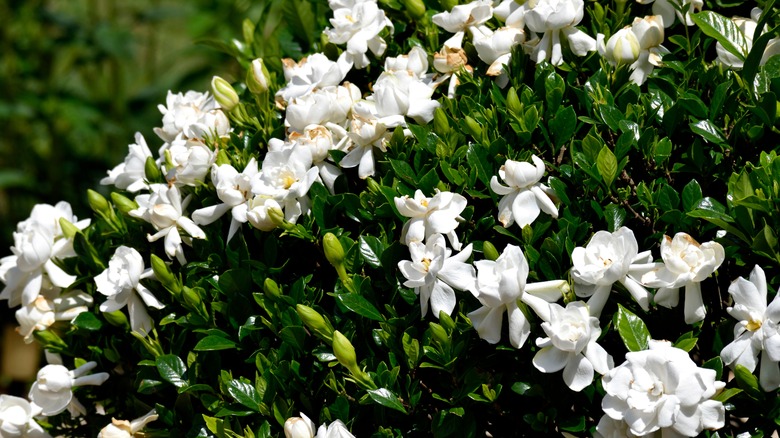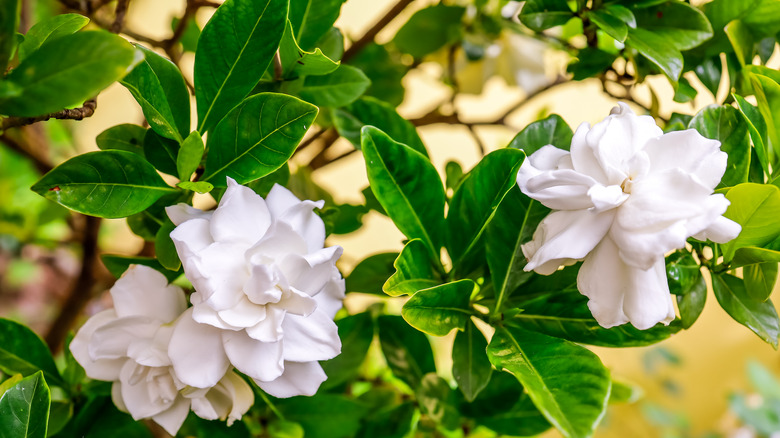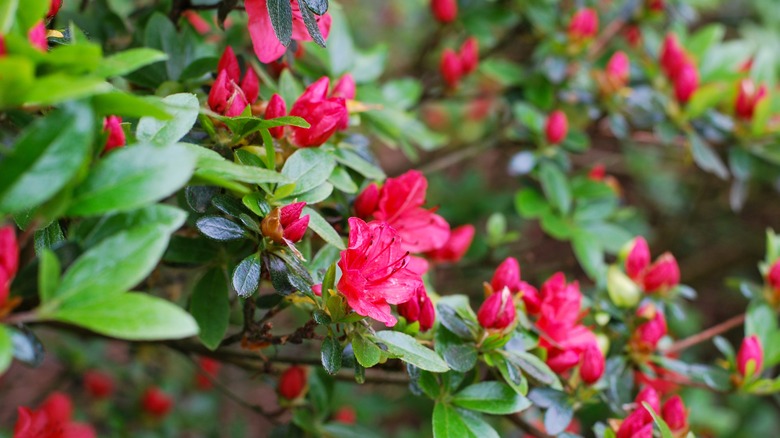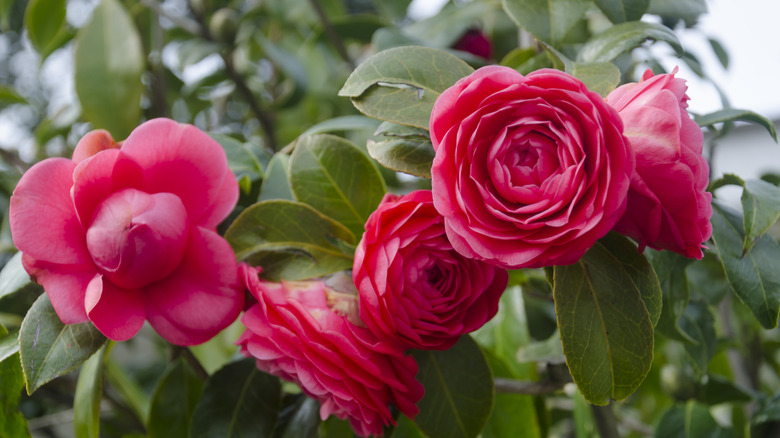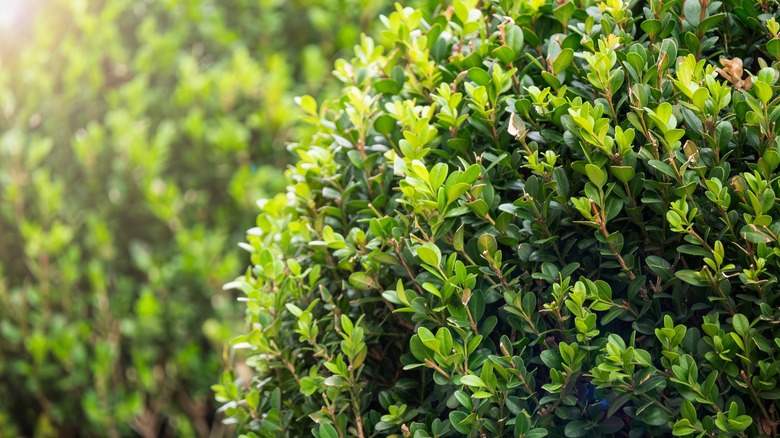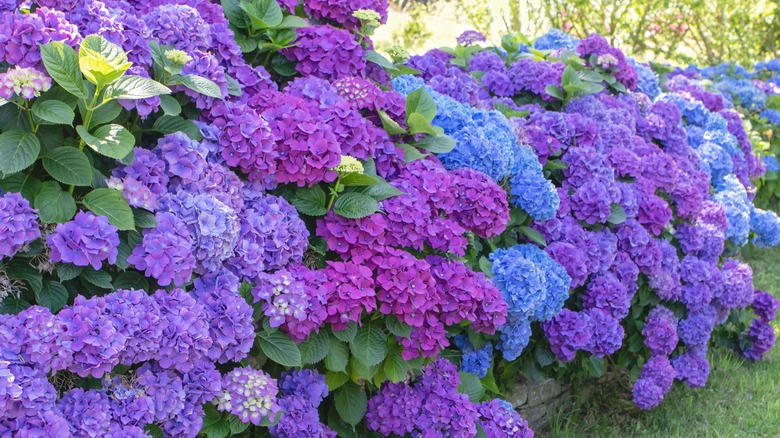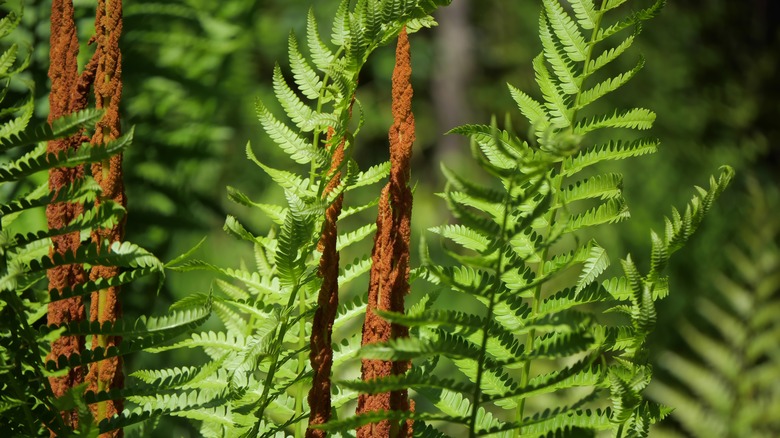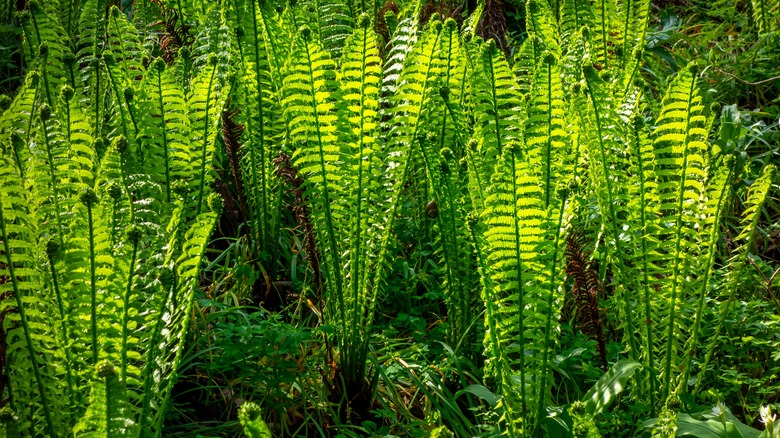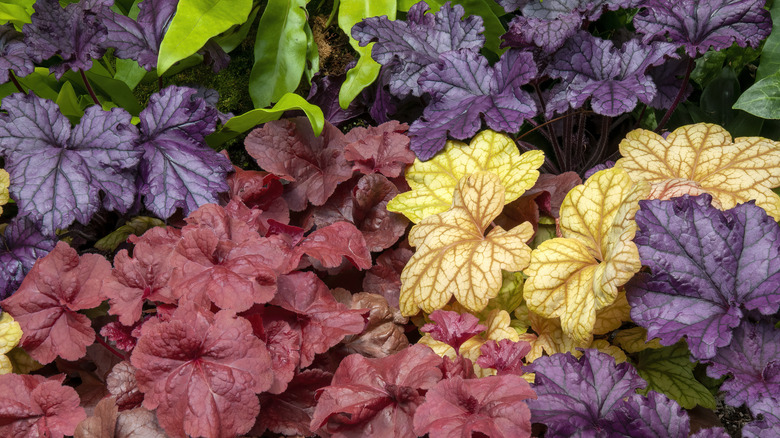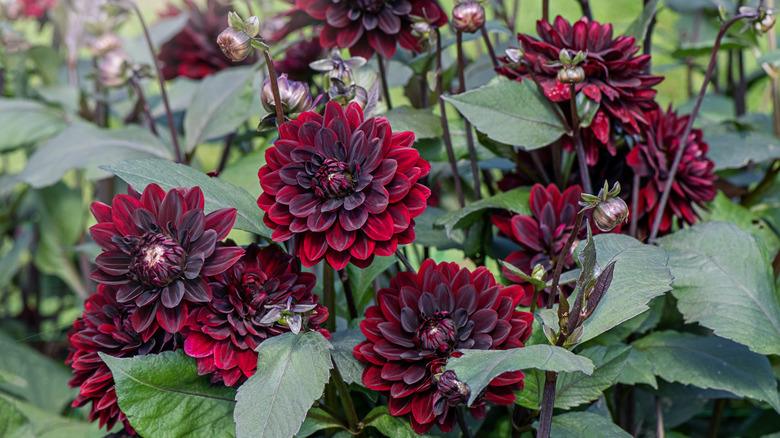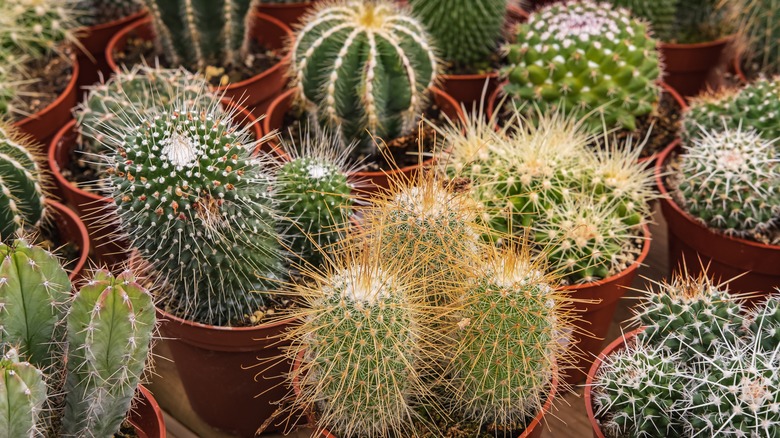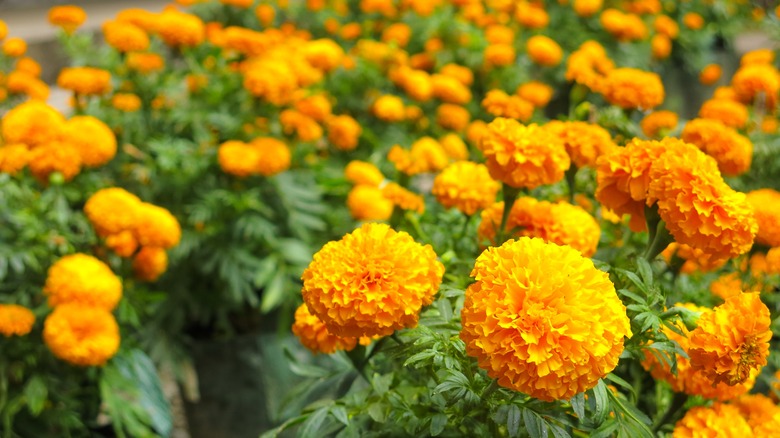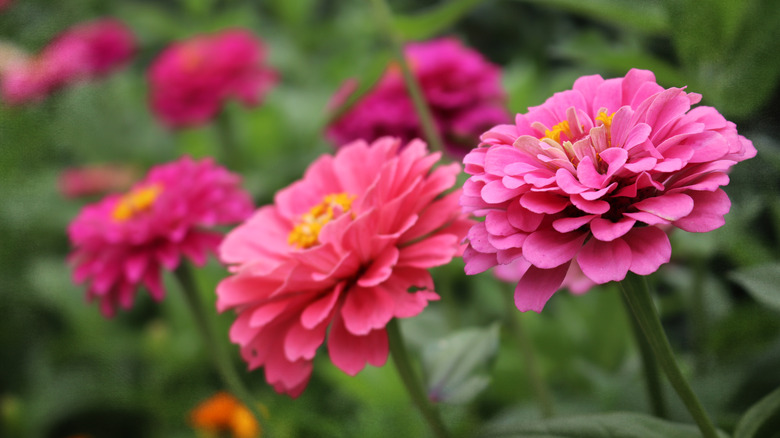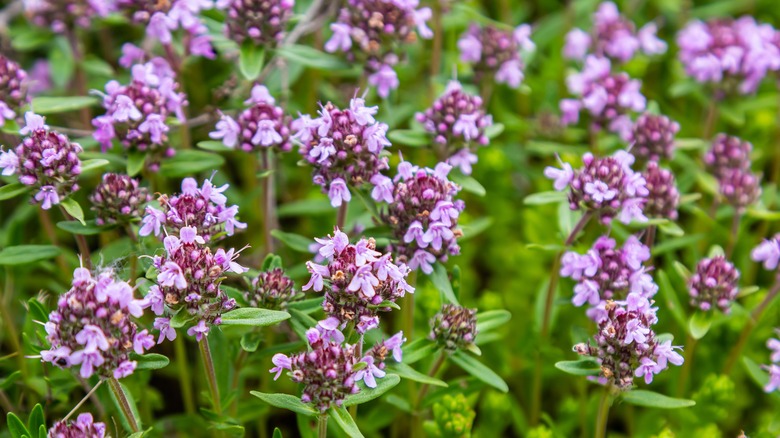Plants You Should And Shouldn't Plant Near Gardenias In The Garden
We may receive a commission on purchases made from links.
First, let's start with a little plant-nerd-history fun fact: When gardenias were introduced to the West in the 1750s, they were originally thought to be a type of jasmine. However, the shrewd horticulture enthusiast and English merchant John Ellis knew better. He instead named the plant "gardenia" in honor of his friend, naturalist Dr. Alexander Garden. If you're curious, yes, the first gardenia shrub eventually reached the U.S. in 1762, happily living in Alexander Garden's garden. Anyhow, we digress.
With their bright white blooms and intoxicating scent, it's no surprise that so many gardeners fall in love at first sight — or whiff — of a gardenia plant. But behind that pretty face lies a slightly high-maintenance care protocol that makes it a prima donna that can only hang with a few other neighbor plants. So, we've rounded up nine of the most gardenia-compatible plants for your garden. Whether they have similar growing condition requirements or non-competing bloom cycles, these plants will coexist peacefully with your gardenia for years. We've also included three absolute no-nos that, while we love them, cannot thrive in the parameters a gardenia would, making at least one plant (and you) pretty sad.
What gardenias need to thrive
First, let's do a quick recap of what a gardenia plant needs to thrive to reference when it's time to go plant shopping. Gardenia jasminoides is an evergreen plant that's part of the coffee family and has been cultivated for over 1,000 years in its native lands of East Asia. They are like the Mariah Carey of the plant world — divas to the end, but they put in the hard work to earn it. Gardenias need acidic soil and can suffer from chlorosis if the pH is too alkaline. The soil also needs to be well-draining yet moist, and don't you dare let it get too dry or too wet. Water them with room temperature water and try not to get any on the blossoms or foliage, thanks.
They prefer some shade, love humidity, and can do surprisingly well as indoor houseplants if properly cared for. However, decide early on whether you want them to live inside or out because they hate having their roots disturbed. Use a fertilizer formulated for acid-loving flowers during spring and summer, but stop once fall hits. You can also add a little bit of fish emulsion or blood meal to give it a nutrient boost, but keep in mind that adding these organic supplements to your gardenias requires a bit of math, and too much can cause root burn if you're not careful.
Azaleas are compatible with gardenias
We talk a lot about compatible plants, but there's rarely a pairing that's more perfect than azaleas (Rhododendron spp.) and gardenias. They have such similar growing conditions that azalea plant food, like this GARDENWISE 8-4-8 acidic fertilizer, is often recommended as a perfect option for nourishing gardenias too. Like gardenias, azaleas do best in spots that are slightly shaded from the bright midday sun and need well-draining, moist soil that has an acidic pH level. If you're not sure what your soil's pH level is, you can get a soil test through most university extensions or purchase a soil pH meter online. If your test results show neutral or alkaline levels, there are ways to make your soil more acidic so that your gardenias and azaleas are both happy.
One thing to keep in mind, though, is the mature size of each plant because you're going to need lots of room. A fully formed azalea can reach 10 feet high and eight feet wide, while gardenias tap out around eight feet square, so you'll need enough space to accommodate both. Remember that gardenias hate having their roots messed with, so try your best to plan their planting space accordingly, considering the placement of barriers like walls or fences in addition to potential plant neighbors. The less you need to move, the better.
Camellias are compatible with gardenias if you plan it just right
Camellias (Camellia japonica) enjoy slightly acidic soil, making them a companion that goes well with gardenias. Like azaleas, camellia shrubs are evergreen behemoths that can reach up to 13 feet high and 10 feet wide, producing up to 6-inch flower monsters in a wide spectrum of colors. Plus, their tendency to bloom through fall and winter in their preferred growing zone (7a through 9b) means they'll be less likely to compete for resources during the height of gardenia's blooming season, typically mid-summer.
However, things aren't as easy as they appear because camellias are their own type of diva that can be a toxic friend to gardenia if not properly cared for. First, despite their massive mature size, camellias take time to grow, and impatient gardeners might start helicopter parenting their plant to death if they're not careful. In addition, camellias create a bit of a gardening paradox when next to gardenias: camellias prefer a little more shade than gardenias, but camellias can grow taller than gardenias, blocking their light, so careful planning needs to take place if you want these two together. Also, scale is a big nemesis for camellias which can be a problem because gardenias are susceptible to scale infestations, too. If an outbreak isn't caught early, it could take out both plants. That said, don't let these cons scare you off; all it takes is a bit of thoughtful, intentional landscape planning to ensure these two gorgeous plants have everything they need.
Boxwood and gardenias are compatible plants
You know what would be cool if you had the space? Making a boxwood maze with a giant gardenia plant in the center as the star attraction. Granted, not many of us have the acreage, but it's a fun thought, nonetheless, because boxwood (Buxus spp.) shrubs balance gardenias so well. They're low-maintenance evergreen shrubs that can handle a variety of pH soil levels, including acidic. Like gardenias, boxwood plants do best in dappled sun situations, but will go with the flow and can tolerate full sun if they need to. But that won't be a problem if you place them next to gardenias in their partial shade happy place, so everything's good.
The best part about using boxwoods next to gardenias is that they are completely malleable and can be pruned to complement the growth of your gardenia, ensuring the two don't get in each other's way. Keep an eye on your boxwood in its first year while it's getting established, and make sure its soil stays moist. Like gardenias, boxwoods are somewhat drought-tolerant but need time to settle in before getting hit with a lack of water stress.
Hydrangeas and gardenias are garden BFFs
The idea of pairing a Hydrangea's (Hydrangea macrophylla) deep blooms with gardenia's creamy, white flowers is enough to make us swoon, so it's good that they're so compatible as neighbors. Hydrangeas have nearly identical sun requirements to gardenia, needing partial shade and protection from the afternoon summer sun. Plus, they tolerate acidic soil like a champ and are excellent judges of pH levels: blue blooms mean you've got acidic soil while pink flowers mean your soil leans more alkaline.
Despite it being a worthy competitor to gardenias in terms of showiness, hydrangeas don't mind if gardenias get to be the golden child of the garden and are generally considered low-maintenance. Some may need regular pruning, while others are less fussy, and most hydrangeas are hardy in USDA Zone 6 and up, but can handle Zone 5 winters if they're well mulched and you've got a nice burlap wrap for them. Like camellias and azaleas, plan your spacing for gardenias and hydrangeas thoughtfully, as this is another pair that can take up a lot of space. Hydrangeas can easily reach up to six feet square and won't be as pleased if they overlap gardenia's foliage.
Cinnamon ferns are compatible with gardenias
Ferns make fantastic pairings for gardenias thanks to their love of moist, humid conditions and aversion to high levels of light. The Cinnamon fern (Osmundastrum cinnamomeum) is a particularly interesting option, thanks to the fibers found near the bottom of fronds that resemble, well, cinnamon. It's a fairly easygoing plant that's hardy in USDA Zones 3 through 9, but really does best in soil that's moist, acidic, and nutrient-rich. If you get its conditions just right, your cinnamon fern will get up to about 5 feet tall, making it a great neighbor for a juvenile or fully-mature gardenia that won't overpower it.
Cinnamon ferns love moisture even more than gardenias, especially in boggy, wetland-type conditions, which may be too much moisture for gardenias to handle, but it's such an adaptable plant. The humidity and moist soil that gardenias want is typically good enough to keep ferns happy. It's a slow-growing fern, so don't worry if your plant seems a little lazy; good things take time.
Royal ferns are compatible with gardenias
Like its cinnamon-named cousin, the Royal fern (Osmunda regalis) is another go-with-the-flow fern that would be happy next to your gardenia. It's an incredibly adaptable plant that's hardy in USDA Zones 3 through 9 and wants only a few things: acidic pH levels, moist soil, and a little shade. Its upright, stately look is also a nice balance to gardenia's bushy shape, making it a good option for adding a little aesthetic intrigue to your landscape design. Plus, during the fall, its fronds will turn a yellowish-brown hue that almost makes it look like your gardenia is bookended with flames. Talk about the perfect scene for a plant as dramatic as a gardenia.
Royal ferns will reach around six feet high and three feet wide, so they're easy enough to plan around a gardenia. Like gardenias, the royal fern needs humidity to thrive, so if levels drop below 30%, you can expect some crispy edges on both plants. Give it plenty of width for growth, just to ensure both it and your gardenia have enough room to be comfortable.
Some varieties of coral bells are compatible with gardenias
If you want a plant that will complement gardenia's flowers without becoming a showy competitor, consider giving Coral bells (Heuchera) a look. Heuchera plants are evergreen and have over 50 varieties in their family tree that run the gamut in terms of color, growing requirements, and maintenance levels. They're low-growing plants, tapping out at a little over a foot and a half high, making them fantastic groundcover with eye-catching, colorful leaves that will make for a stunning backdrop to your gardenia flowers.
Generally speaking, most heucheras love similar growing conditions to gardenias: moist, well-draining soil that's slightly acidic. However, there are only a few that match the partial shade and humid air requirements gardenias need. For that, you'll need to find cultivars that are from the heuchera villosa species, which is native to the Americas and designed to handle slightly-shady-slighty-moist conditions. Luckily, that doesn't mean you're stuck with only one cultivar, as there are lots of villosa offshoots that come in nearly any color possible.
Some dahlias are compatible with gardenias, but with a caveat
Dahlias (Dahlia spp.) are dramatic, show-stopping flowers that make semi-compatible neighbors for gardenias. First, let's start with the good: dahlias are big fans of moist but well-draining and slightly acidic soil, ideally around a pH of 6.5, which is right at the top of gardenia's range of 5.0 to 6.5. They do love full sun, but can tolerate the dappled shade gardenia prefers. Plus, their deep colors and the not-too-tall maximum mature height of 6 feet mean your gardenia shrub can be center stage where it deserves.
However, planting dahlias with gardenias can be complicated for one big reason: roots. Dahlias are considered annuals in USDA Hardiness Zones 1 through 6b. However, once you get into Zone 7, there's a chance you can turn your dahlia into a perennial by digging up and drying the tubers. But as we've mentioned, gardenias do not want their roots messed with, becoming so dramatic that the Missouri Botanical Garden describes it as resentment from the plant for the audacity of disturbing them. Getting too close to your gardenia's roots or, God forbid, accidentally touching them with garden tools, can wreak havoc that your plant won't readily forgive. So resolve to plant them once and then never again, if only to save yourself from having to tell someone, "My gardenia resents me."
Cacti and succulents are not compatible with gardenias
Cacti and succulents are pretty easygoing plants that can handle, and maybe even prefer, some neglect, making them popular plants for gardeners of any skill level. However, their preference for high light and dry conditions makes them completely incompatible with gardenias. If you want something that's more tolerant of partial light and higher humidity that's cacti or succulent-adjacent, give the Round leaf peperomia (Peperomia rotundifolia) a try as its fleshy leaves make it seem as close to a succulent as possible. Just be sure it gets slightly more sun than your gardenia.
On the other hand, if you're looking for something gardenia-like to complement your cacti collection, the Fragrant sand verbena (Abronia fragrans) and Mound lily yucca (Yucca gloriosa) both have bright white flowers that are heavily fragrant and thrive in the dry, sandy soils that desert plants love.
Marigolds should not be planted with gardenias
Growing marigolds can be simple, but identifying them can get confusing, as there is more than one plant with that name. Tagetes is considered the "true" genus for marigolds, but Calendula officinalis seems to keep getting stuck with the marigold name, too, despite its being a different genus altogether. Regardless, whichever marigold you're thinking of, it's most likely not going to be happy living next door to gardenias. Tagetes need full sun and well-draining, loamy soil. They do prefer slightly acidic soil, but if it gets too acidic, the marigolds begin to develop nutrient deficiencies. Calendulas also like well-draining soils and full sun but prefer their soil to be at a pH level of 6 to 7. Calendulas can handle more acidic conditions and partial shade if they need to, but we want everyone to be happy with their living situation, so it's just best to keep gardenias and marigolds separate.
If you want to add a little orange pizzazz to your gardenias, try orange-colored impatiens (Impatiens walleriana). If you're looking for a gardenia-like option to grow next to marigolds, try the Burning bush (Dictamnus albus) — just be sure to keep an eye on your soil pH to keep both happy.
Zinnias need more sun than gardenias can handle
Zinnias are so versatile; it's sort of amazing how adaptable they can be. Plus, they make excellent flowers for a pollinator garden and play nice with a variety of herbs and flowers. Unfortunately, gardenias just aren't one of them, and that's due to zinnias' unique care needs, especially their need for full sun. Those big, beautiful flowers come at a cost to the plant and require lots of light to generate the resources it needs to make such spectacular blooms, so a partial shade setup next to gardenias just isn't going to cut it.
If you want something to match the zinnia's pops of color that can better handle gardenia's growing conditions, try the Chenille plant (Acalypha hispida), as it's incredibly adaptable to most soil pH levels as long as it gets some shade and high humidity. Just be aware it can get bushy quickly, so will need some space away from your gardenia. On the other hand, if you want something gardenia-like that pairs better with zinnias, check out Asiatic jasmine (Trachelospermum asiaticum), which is super fragrant and does great in full sun and well-draining soil. It's more of a groundcover than a shrub, though, so if you'd prefer something a little bushier, the Japanese snow flower (Deutzia gracilis) is a good pick.
Thyme is totally incompatible with gardenias
We're sad to put this one on the bad list, because it's such a hardy plant. Thyme (Thymus spp.) checks off a lot of positive boxes, which is why it's such a popular herb for gardens; it's low maintenance, the herb is delicious, pollinators love it, and it does an excellent job suppressing weeds as a groundcover. But for all the good it does, thyme is just too different from gardenia to work together even a little. While gardenia loves humidity, thyme likes it dry. When gardenia wants shade, thyme wants the sun. In the end, these two together spell disaster for at least one plant and are best kept on opposite ends of the garden.
If you want an herb companion for your gardenia, check out Caraway (Carum carvi). It's versatile, can handle partial shade, loves well-draining but moist soil, and readily tolerates acidic pH levels. However, like gardenias, it also hates having its roots disturbed, so make sure this is a plant you really want because you're almost guaranteed to have an epic drama scene with both plants if you end up fussing with it later. On the other hand, if you want a fragrant flower companion for thyme, try the Mountain snowbell (Ceanothus americanus), a shrub that's native to the Americas and can do well in the same rocky soils thyme does. But if you want a pairing that's a little more well-known, thyme and lavender make natural garden companions, and there are white flower cultivars of Lavandula now available — Findlavender sells Lavender White Spike live plants on Amazon, or if you prefer to grow from seed, try Hirt's gardens Elegance Ice Lavender seeds.
